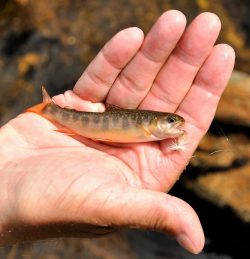 Trout are not as big as they used to be! Part of this is that all fish we caught were bigger back in the day since we were smaller, or the fish have increased in size over the years. The truth is that in general, trout in our public waterways are not as big as they used to be.
Trout are not as big as they used to be! Part of this is that all fish we caught were bigger back in the day since we were smaller, or the fish have increased in size over the years. The truth is that in general, trout in our public waterways are not as big as they used to be.
There are several reasons why this true.
Too much pressure! In my early days guiding on the Bighorn River, it was common to encounter a dozen trout over 25 inches a day. Now the fish are maybe 18-20 inches, dark colored, stressed, lip torn, skinny, and wore out. Catching a trout that has no hook scars is rare. Many of the rainbows come from the after-bay releases in this artificial fishery. Cold water releases from the dam turned this river into a trout fishery. Many of our Blue-Ribbon trout fisheries are still evolving and changing.
Too many fishermen! A trout can be caught and released only so many times before the stress or injury kills it. Even with perfect handling, small trout rarely grow to be big trout after having their lips ripped several times. After getting caught and released, fish may not feed for weeks. Fish need to survive long enough to get huge.
Poor catch and release techniques/cellphone picture time. A trout can only be caught and released so many times. At some point the fish will be injured mortally, stop eating, or become vulnerable to other predators. In field picture taking increases the time that fish are out of water. This has dramatically increased fish mortality.
Guided trips catch more fish than fishermen just trying to fish. More fish caught means more mortality and more big fish being kept. Guides are on the river regularly and in tune with what works. Catch rates are higher with a guide. This added success eventually impacts trout populations in a negative way.
BIG Fish that are released often die from the stress. The lactic acid in a fish’s muscles builds up fast. If a fish battles longer than 3-4 minutes, chances of survival are less. Throw in the time to take pictures and the trout is doomed.
BIG trout are no longer routinely stocked. Many of the huge trout taxidermy fish we see in our local bars, shops, and restaurants, are from the days of stocking. As a kid, I remember stocking several trout in a main pool on the Gallatin River. The stocking truck pulled up and I volunteered to help. The buckets I helped to carry would not fit one trout completely. Their tails stuck out the top. Many of these fish were well over 25 inches long. There is not enough time or food in most wild rivers for trout to get fat and long.
If Big Fish are kept, they are now gone from the waters and genepool. Big fish require more food and space to live. Many large trout are also cannibalistic. This is good for the small fish but…
Wild fish must survive long enough to get big. There is not enough food in most wild places to fatten up fish. Without several years of free feedings at a hatchery, fish will not become pigs.
Nature and changing ecosystems are impacting traditional fishing opportunities. Yellowstone Park waters have heated up with increased geothermal activity. These primary waters feed our main MT rivers. Global warming means warmer waters and less trout habitat.
Big fish from the past have been exaggerated in their size. Fishermen tend to lie about how many and how big their catch is. At least a 20% increase is routinely exaggerated.
Size does matter!
Montana Grant
For more Montana Grant, visit is blog or Facebook page at www.montanagrantfishing.com.